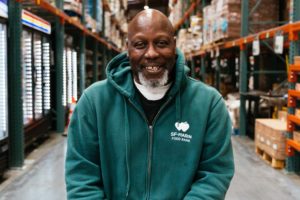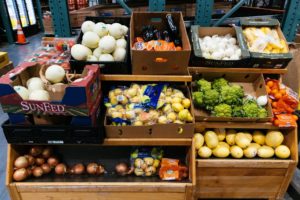 Step onto the shop floor at the Pennsylvania Warehouse and you’ll be greeted by racks filled with just about every item under the sun: fresh fruits and vegetables (of course), canned beans and proteins, fresh breads and pastries, eggs, frozen proteins like chicken breasts, and assorted dry, fresh, and frozen grocery items from supermarkets all over San Francisco.
Step onto the shop floor at the Pennsylvania Warehouse and you’ll be greeted by racks filled with just about every item under the sun: fresh fruits and vegetables (of course), canned beans and proteins, fresh breads and pastries, eggs, frozen proteins like chicken breasts, and assorted dry, fresh, and frozen grocery items from supermarkets all over San Francisco.
Through our “shop” program, we serve 243 partners in the community. Here’s how it works: on any given weekday, by appointment or drop-in, agencies ranging from congregate meal sites to afterschool programs can stop by the warehouse and shop for groceries from 8am-3pm.
Donations and Fresh Rescue Lead the Way
These Food Bank shop partners “pick up free produce, bread for 8 cents/pound, and other donated items for 18 cents/pound,” said Henry Randolph, Senior Shop Floor Manager at the Food Bank. “Produce comes to the Food Bank through the Farm to Family program just like it does for food pantries. But the other food we offer comes from community donations, or through our Fresh Rescue program. We’ll go out to local supermarkets like Whole Foods, Lucky’s, Safeway, Amazon and Costco, and bring back a variety of different products for our shoppers.”
Flexibility, Variety, Affordability
One partner, the Homeless Church of San Francisco, has been coming for the past three decades. Since they don’t operate a traditional pantry, the flexibility and price point of the shop floor is a huge draw.
“At the place where we live, we bring in [unhoused] guests and we serve lunch and dinner five days a week. And we go out to different camps across San Francisco on Thursday and Friday nights and serve a full meal. On Sunday morning, we cook pancakes and serve them at the Embarcadero. And we also give out food boxes to around 30 people who live in hotels,” said April Prosser, co-founder of the Homeless Church along with her husband Pastor Greg Prosser. “So, we have a variety of needs. The donations from the Food Bank allow us to have really good meals.”
Community Support Remains Crucial
The Food Bank helps hundreds of partners meet the unique needs of their programs and agencies. But Henry says that lately, “demand is very high, with a limited supply,” because of inflation and supply chain issues, driving home the need for continued support from our community as we strive to keep our shop floor racks full for our neighbors and partners.
Henry says that lately, “demand is very high, with a limited supply,” because of inflation and supply chain issues, driving home the need for continued support from our community as we strive to keep our shop floor racks full for our neighbors and partners.
In Henry’s words: “We’re trying to do the best we can. But if the Food Bank is hungry, how can we feed other people?”
Through Challenges, Relationships Remain
Regardless of current challenges, one thing remains stable: the relationships formed between Food Bankers and long-term shop partners. “I can think of a handful of agencies, like the Homeless Church, that have been shoppers for close to 30 years. And I think that’s really special because we all have a common goal: to provide services to our community. There are a lot of compassionate people that are really dedicated,” Henry shared.
The feeling is mutual: April says that “from the beginning, the Food Bank has been a lifesaver. And Henry is a real blessing.”



Share